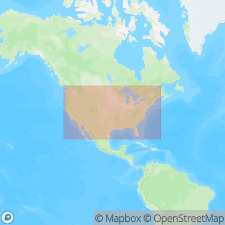
- Usage in publication:
-
- Oyster Ridge sandstone
- Modifications:
-
- Areal extent
- Dominant lithology:
-
- Sandstone
- AAPG geologic province:
-
- Central Western Overthrust
- Green River basin
Summary:
Pl. 12. Oyster Ridge sandstone, in Colorado formation. [Text states that 400 feet below top of Colorado formation in southern Uinta County (southwestern Wyoming), is a pronounced bed of coarse sandstone, occasionally conglomeratic, containing numerous large oysters and known as "Oyster Ridge sandstone." Age is Late Cretaceous.]
Source: US geologic names lexicon (USGS Bull. 896, p. 1581-1582).
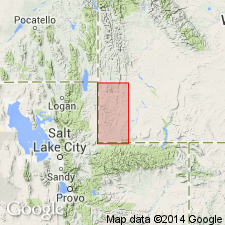
- Usage in publication:
-
- Oyster Ridge sandstone member*
- Modifications:
-
- [Principal reference]
- Biostratigraphic dating
- Dominant lithology:
-
- Sandstone
- AAPG geologic province:
-
- Central Western Overthrust
- Green River basin
Summary:
Oyster Ridge sandstone member of Frontier formation. Pronounced bed of coarse sandstone, occasionally conglomeratic and containing numerous large oysters; in upper part of Frontier formation. Forms pronounced ridge named Oyster Ridge by Hayden in 1872 [Uinta County, southwestern Wyoming]. Thickness usually 200+/- feet. [Mapped and fossils listed. Age is late Cretaceous.]
Source: US geologic names lexicon (USGS Bull. 896, p. 1581-1582).
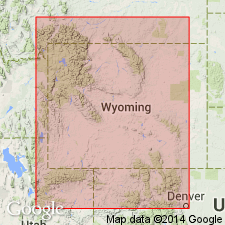
- Usage in publication:
-
- Oyster Ridge sandstone member*
- Modifications:
-
- Biostratigraphic dating
- AAPG geologic province:
-
- Uinta uplift
- Green River basin
Summary:
Pg. 1922 (fig. 2), 1924-1925, fig. 4. Oyster Ridge sandstone member of Frontier formation. Chiefly sandstone with marine fauna of early Carlile age (Turonian). Thickness 134 feet. Lies below unnamed nonmarine mudstone, sandstone, and siltstone with "Kemmerer coal group" at top, 260 feet; lies above unnamed shale with marine fauna of late Greenhorn and early Carlile age (Turonian), 300 feet. Fossils [listed]. Age is Late Cretaceous, [early middle] Turonian; CALLIGNONICERAS WOOLLGARI-SCAPHITES LARVAEFORMIS fossil assemblage zone.
Section measured (in Frontier formation type area) about a mi north of Cumberland Gap, about 15 mi south of town of Frontier, in N/2 secs. 31 and 32, T. 19 N., R. 116 W., [Cumberland Gap 7.5-min quadrangle], Lincoln Co., southwestern WY.
Source: Publication.
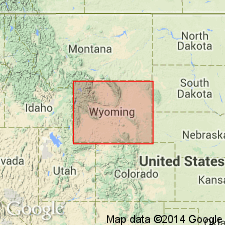
- Usage in publication:
-
- Oyster Ridge sandstone member*
- Modifications:
-
- Areal extent
- AAPG geologic province:
-
- Central Western Overthrust
- Green River basin
Summary:
Mapped in upper part of Frontier formation. [Age is Late Cretaceous.]
Source: US geologic names lexicon (USGS Bull. 1200, p. 2884).
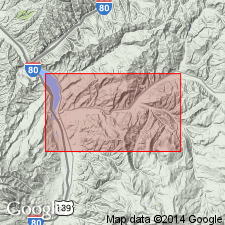
- Usage in publication:
-
- Oyster Ridge sandstone member
- Modifications:
-
- Areal extent
- AAPG geologic province:
-
- Central Western Overthrust
Summary:
Pg. 136 (chart 1), 140, 141. Oyster Ridge sandstone member of Frontier formation. Overlies Allan Hollow shale member (new); unconformably underlies Dry Hollow member (new). Basal Oyster Ridge is 45 to 80 feet thick. Upper part of member is 150 to 200 feet of interbedded green to brown shale and sandstone. [Age is Late Cretaceous.]
Source: US geologic names lexicon (USGS Bull. 1200, p. 2884).
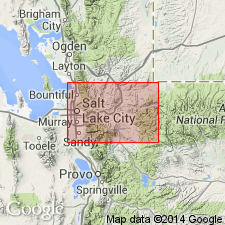
- Usage in publication:
-
- Oyster Ridge Sandstone Member*
- Modifications:
-
- Biostratigraphic dating
- AAPG geologic province:
-
- Uinta uplift
Summary:
Is a member of the Frontier Formation that contains the pollen NYSSAPOLLENITES which bears a Cenomanian to Coniacian age. Report area is in Summit Co, UT in the Uinta basin. Also contains the early middle Turonian ammonite, COLLIGNONICERAS WOOLGARI.
Source: GNU records (USGS DDS-6; Denver GNULEX).
For more information, please contact Nancy Stamm, Geologic Names Committee Secretary.
Asterisk (*) indicates published by U.S. Geological Survey authors.
"No current usage" (†) implies that a name has been abandoned or has fallen into disuse. Former usage and, if known, replacement name given in parentheses ( ).
Slash (/) indicates name conflicts with nomenclatural guidelines (CSN, 1933; ACSN, 1961, 1970; NACSN, 1983, 2005, 2021). May be explained within brackets ([ ]).

